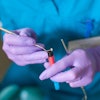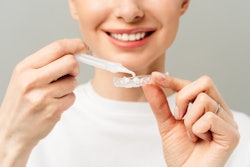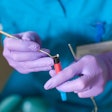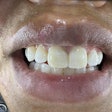Editor's Note: This is the first of a series in which we will ask dental experts to evaluate the smiles of celebrities and well-known individuals from all walks of life.
U.S. Health and Human Services Secretary Robert F. Kennedy Jr. (RFK Jr.) doesn’t make dentists smile, and it has nothing to do with his antifluoride crusade. It’s whatever is going on with his teeth.
A recent photo of RFK Jr., who has claimed that the cavity-fighter fluoride is an “industrial waste associated with arthritis, bone fractures, bone cancer, IQ loss, neurodevelopmental disorders, and thyroid disease,” circulating the web shows white gunk in his front teeth and something else along his gum line may have some wondering whether he should be calling the shots about dental health.
So, DrBicuspid asked some experts what's up with the health czar’s teeth.
Dr. Joseph Field, a cosmetic and reconstructive dentist at the Peninsula Center of Cosmetic Dentistry in Los Altos, CA, said, “RFK Jr.’s teeth show classic signs of long-term wear, visible gum recession, enamel erosion, and gapping that could compromise both function and aesthetics. Without x-rays, I can't assess decay directly, but that’s exactly the point: Decay prevention is fluoride’s strongest, most consistent benefit. If there’s irony here, it’s that the mouth making headlines for fighting fluoride shows the kind of damage fluoride is designed to help prevent.”
Dr. Tyler Hales, of Hales Aesthetic in Irvine, CA, noticed a few things going on with RFK Jr.’s teeth.
“For one, it shows that the teeth are worn down and flat, which is a sign that he is a heavy grinder,” Hales said. “This can cause his teeth to break or chip over a period of time. It is also evident that he has gum recession. This could be due to his grinding and severe stress he is putting on his teeth. Over time, as the recession progresses, he may have needed a gum graft to help cover the roots of his teeth and help protect them from more wear. This is what the white paper could be in the picture and part of the healing process from the gum graft.”
Dr. Pia Lieb, a cosmetic dentist in New York City, had another thought about what that white paper is near his gumline.
“Robert F. Kennedy Jr. appears to have something between his upper left teeth, possibly a food particle, but more likely the edge of a Zyn pouch, a smokeless nicotine product,” Lieb said. “Additionally, there are signs of mild gum and bone recession common with age but potentially worsened by oral habits like pouch use. On the posterior left side, a white element resembling a Zyn pouch tucked into the gum line is visible. This placement can cause chronic tissue irritation, localized recession, and long-term oral damage. Though marketed as a cleaner alternative to tobacco, Zyn carries health risks: gum irritation, elevated blood pressure, anxiety, increased risk of oral cancer, and cardiovascular strain.”
Dr. Jeremy Manuele of Hamilton & Manuele Orthodontics in Las Vegas agreed that’s probably a nicotine pouch in RFK Jr.’s mouth.
“Although often marketed as a ‘cleaner’ or ‘safer’ option, nicotine pouches are not without consequence,” Manuele said. “Nicotine -- even without combustion -- leads to vasoconstriction, reduced salivary flow, and soft-tissue irritation. In my practice, I’ve seen patients develop localized recession, ulcerations, and tissue breakdown in the very areas where pouches are habitually placed. These effects can be lasting and irreversible. A 2023 analysis published in JADA (Journal of the American Dental Association) confirmed that prolonged use of nicotine pouches can increase the risk of soft-tissue lesions and chronic periodontal inflammation. Dependency is another clinical concern, as nicotine exposure -- even from ‘tobacco-free’ sources -- can complicate both dental care compliance and broader medical outcomes.”
Manuele said this matters.
“Typically, this would be a personal health matter. But Robert F. Kennedy Jr. is no ordinary citizen -- he has been nominated to lead the U.S. Department of Health and Human Services, the agency tasked with shaping national public health policy,” Manuele said.
“Using a nicotine pouch, in plain view, during a live congressional hearing sends a deeply conflicting message -- particularly as dental professionals work to curb oral nicotine product use among adolescents and young adults. As clinicians, we’re trained to look beyond appearances and understand root causes. And in this case, the optics matter. Public trust in health leadership depends on credibility and consistency. What we model -- especially at the highest levels -- sets the tone for prevention, education, and policy enforcement.”
Dr. Michelle Jorgensen, a holistic dentist, said RFK Jr.’s teeth may be indicative of an even more serious issue.
“Look closely and you’ll see flat, worn front teeth and gaps forming,” Jorgensen said. “That’s not bad brushing. It’s what happens when the body, desperate for oxygen, pushes the lower jaw forward, especially at night. It’s the body’s built-in survival mechanism trying to open the airway. RFK Jr.'s teeth are whispering what his body might be shouting: ‘I can’t breathe.’ This kind of jaw shifting and nighttime grinding is often linked to airway obstruction, something we see in patients with sleep-disordered breathing. It’s not cosmetic. It’s potentially dangerous. Poor oxygen at night can fuel everything from high blood pressure and chronic fatigue to stroke and memory loss.”
Jorgensen suggests that he undergo a simple cone-beam computed tomography scan at a sleep-focused dental office to determine the truth.
“He’s pushing for a healthier America -- and that starts with making sure he’s breathing well enough to lead it,’ Jorgensen said.
Dr. Jason Auerbach, an oral surgeon in New Jersey and the founder and co-chief executive officer at DSO Max Surgical Specialty Management, noticed several issues with his teeth.
“Based on the photo, you can see significant wear along the biting edges of Mr. Kennedy’s upper front teeth, Auerbach said. “That pattern is often associated with years of clenching or grinding, which is a mechanical process unrelated to fluoride. There also appears to be open spaces between some of the teeth near the gumline, which can occur with periodontal bone loss or gum recession over time.”
Furthermore, “his well‑known position on fluoride, however, is more relevant to the risk of dental caries (cavities) than to periodontal health or the kind of incisal wear we’re seeing in the photo,” Auerbach said. “Periodontal breakdown and attritional wear are driven by entirely different factors than fluoride exposure.”
The comments and observations expressed herein do not necessarily reflect the opinions of DrBicuspid.com, nor should they be construed as an endorsement or admonishment of any particular idea, vendor, or organization.




















